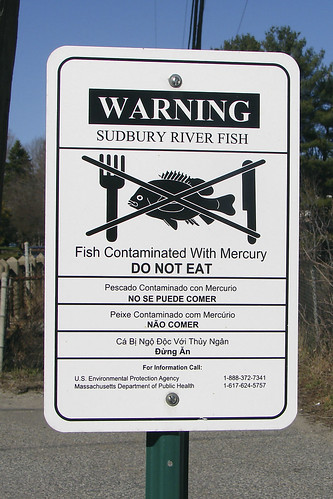By David Riley/Daily News staff
The MetroWest Daily News
Posted Feb 21, 2010 @ 02:15 AM
I knew this would come out, eventually. Even I, with only a cursory self-education in the topics of hydrology, geography and geology, knew without a shadow of a doubt that we were screwed.
These signs are around for a reason!
Even I knew that capping a toxic chemical dump made no sense.
Questions: So . . . we don't eliminate any toxins, but we keep them underground? By pouring cement on top? Isn't cement a porous and permeable substance? What happens to the poisons underneath the cement? What contains them from spreading into the water?
Answers: Capping a toxic dump hides it from view. Eventually trees and grass will grow, and people forget it's dangerous. It accomplishes nothing in regards to protecting the water supply or the soil where we get our crops.
It looks like a harmless field.
"The U.S. Environmental Protection Agency previously found dense chemicals in the bedrock"Ground water, as the name implies, is water found below the land surface in the pore spaces between sand grains and in fractures in the bedrock. (Maine Geological Survey)
Chemicals in the bedrock, therefore, means there are chemicals in the GROUNDWATER! Some people are not aware that GROUNDWATER IS EVERYWHERE, and that GROUNDWATER MOVES EVERYWHERE!
"Much like the flow of water in a river, however, the flow of ground water is subject to gravity and is almost always in motion, flowing from areas of higher elevation to areas of lower elevation. (In the case of ground water in confined aquifers, it is pressure rather than gravity that makes water move. In this case, water flows from areas of high pressure to areas of low pressure.)" PURDUE UNIVERSITY, "GROUNDWATER BASICS"
Note: if "nearby groundwater" is contaminated, then far away groundwater is contaminated, too. (see above)
AT NYANZA, the "Nearby groundwater, however, still shows elevated levels of chemicals once used as solvents"While the EPA is still making sense of the results, DiLorenzo said the most likely explanation is contamination seeped into deep fractures in the bedrock. That would make it harder to find and potentially hundreds of feet into the bedrock - beyond the reach of existing technology, he said.
"You can't dig through it,'' said DiLorenzo. ``You can't blast through it."
The toxins are there, but beyond our reach. If we somehow located these chemicals, containing them or decontaminating them are beyond our capabilities. In other words . . . we're screwed!
over a 60-year period of industrial use ending in 1978, an estimated 20,000 to 30,000 pounds of mercury were released into the environment from a variety of sources at the Nyanza federal Superfund site in Ashland. Much of that mercury made its way into the Sudbury River. Although there has been no industrial activity on the site for 18 years, fish taken from the river today still are not safe to eat. (Massachusetts department of environmental protection)
The Sudbury River, where dye companies dumped mercury for decades, remains contaminated . . .
The only consolation is knowing that virtually every inch of the United States is equally contaminated.
But we don't need any one's pity or censure, however. Find someplace where it isn't just as contaminated before climbing on your high horses. The whole world has to work together to solve this problem! Remember, if its in the groundwater, it is EVERYWHERE!






No comments:
Post a Comment
I love positive comments, critical comments,and corrections most of all!